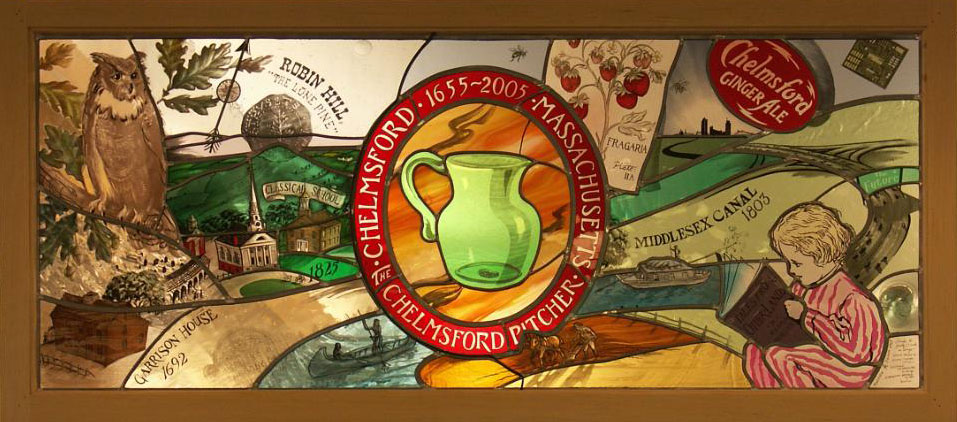
Matthew Fallon’s Stained Glass Panel

Artist Matthew Fallon was commissioned by the town’s 350th anniversary Cultural Activities Committee to create a stained glass panel to celebrate the town of Chelmsford’s 350th anniversary. The panel was installed on the first level of the main library in May 2005. Matthew Fallon submitted the following biography and description of the panel to the 350th Committee.
About the artist:
Matthew Fallon was born and raised in Chelmsford in a much simpler time. He considers himself fortunate to have parents and siblings who encouraged his creative impulses (and tolerated the resultant trails of chaos and debris!). He enjoyed the good art programs in Chelmsford Public Schools, and received a BFA from Massachusetts College of Art. He caught the “stained glass bug” through many years of admiring the excellent windows in Saint Mary’s Church. He is currently employed at Serpentino Stained Glass of Needham. His focus today is primarily repair and conservation of older windows and he has been lucky to have helped preserve many stained glass masterworks, including Trinity Church in Boston and Temple Emanuel in New York City.
A Description of Matthew Fallon’s Panel:
This glass panel is meant to represent the thought stream of images and words that float through the brain when one peruses a book. As the Beatles put it more poetically in the song Across The Universe, “…thoughts meander like a restless wind…” There is no fixed plane, scale, or perspective. I’m constantly amazed by books. Inert blocks of plant pulp and ink, they are living worlds connecting us vividly with the past, present, and future.
Most of the imagery in the panel represents the history of Chelmsford and surrounding area, and flows from left to right. The left half shows earlier scenes. Native Americans before European contact, fishing in Beaver Brook, or the Merrimack. Nearby is the famous Garrison House, and a faint image of a colonial-era tombstone, like the many in The Forefathers Burying Ground. Moving up, there is a cluster of buildings from the Town Common: the stately Unitarian Church, the 1802 School, and the once renowned Classical School (now sadly gone) where Ralph Waldo Emerson taught. Behind rises Robin Hill, crowned with the legendary “Lone Pine.” To represent it, I have used the image from the ancient Pine Tree Shilling, the iconic first coin of The Massachusetts Bay Colony. Beyond Robin Hill, fields and farms (including a tiny picture of The Captain John Butterfield House at 96 North Road-my family home for 42 years) stretch away to purple mountains of “The Northern Kingdom,” indicated by the antique style compass arrow. In the upper left a Great Horned Owl views the scene from a perch on an oak branch. The oak traditionally symbolizes “The Tree Of Knowledge” and the bird is, of course, symbolically “The Wise Old Owl.” It’s also a personal reference to the stuffed owl in the glass case that used to scare the heck out of me during library visits as a young child! In the center is the Chelmsford Pitcher logo for the 350th anniversary, against a field of orange and yellow, representing the flames of the glass furnace.
Below, a local farmer plows his field, and just beyond, the river has transformed into the Middlesex Canal, with a canal barge. An engineering marvel in its time, the canal is all but forgotten now. Such is the passage of time. The canal itself then transforms into a modern highway (complete with heavy traffic!) pointing to “the future” and an anonymous city, symbolizing the world beyond. Libraries are often our first windows into the world at large. The little child in the flannel pajamas simply represents happy warm memories of looking through books. You can never start too young. Behind the child is a piece of original Chelmsford glass, found during renovation on the aforementioned Butterfield house. Floating above is an illustration of strawberries, the last remaining cash crop of local agriculture. The attendant bees are a traditional symbol of industriousness. The Chelmsford Ginger Ale logo needs little explanation, and as of now, a version of it is still being produced.
Finally, in the upper right, is a representation of a microchip, omnipresent element of the modern age, included as a cautionary note. As a resolute Luddite I observe the inexorable march of computer technology and wonder where it will ultimately lead the human race. So seductive with its magnetic ink and the blue genre of the computer screen, promising ease and leisure and unlimited information. I have my doubts. Will “bricks and mortar” libraries for example, become mere Internet cafes before too long?
Matthew Fallon, May 2005
This project was supported in part by the Friends of the Library and by a grant from the Chelmsford Cultural Council, a local agency supported by the Massachusetts Cultural Council, a state agency.






